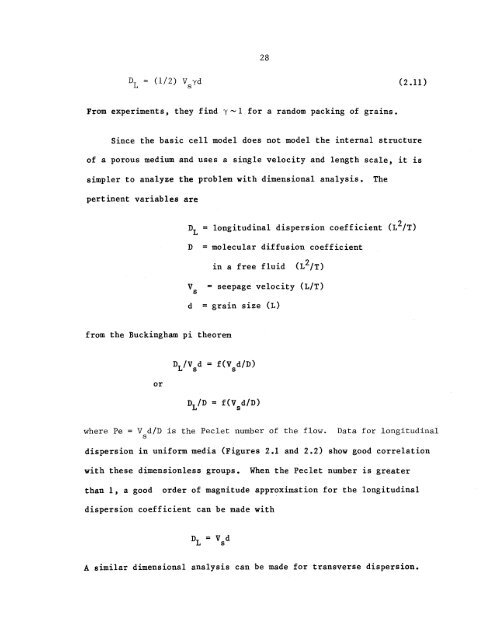longitudinal dispersion in nonuniform isotropic porous media
longitudinal dispersion in nonuniform isotropic porous media
longitudinal dispersion in nonuniform isotropic porous media
Create successful ePaper yourself
Turn your PDF publications into a flip-book with our unique Google optimized e-Paper software.
(1/2) V yd<br />
s<br />
From experiments, they f<strong>in</strong>d y-1 for a random pack<strong>in</strong>g of gra<strong>in</strong>s.<br />
28<br />
(2.11)<br />
S<strong>in</strong>ce the basic cell model does not model the <strong>in</strong>ternal structure<br />
of a <strong>porous</strong> medium and uses a s<strong>in</strong>gle velocity and length scale, it is<br />
simpler to analyze the problem with dimensional analysis. The<br />
pert<strong>in</strong>ent variables are<br />
from the Buck<strong>in</strong>gham pi theorem<br />
or<br />
DL = <strong>longitud<strong>in</strong>al</strong> <strong>dispersion</strong> coefficient (L 2 /T)<br />
D = molecular diffusion coefficient<br />
<strong>in</strong> a free fluid (L 2 /T)<br />
Vs = seepage velocity (LIT)<br />
d = gra<strong>in</strong> size (L)<br />
= f(V diD)<br />
s<br />
where Pe = V diD is the Peclet number of the flow. Data for <strong>longitud<strong>in</strong>al</strong><br />
s<br />
<strong>dispersion</strong> <strong>in</strong> uniform <strong>media</strong> (Figures 2.1 and 2.2) show good correlation<br />
with these dimensionless groups. When the Peclet number 1S greater<br />
than 1, a good order of magnitude approximation for the <strong>longitud<strong>in</strong>al</strong><br />
<strong>dispersion</strong> coefficient can be made with<br />
D = V d<br />
L s<br />
A similar dimensional analysis can be made for transverse <strong>dispersion</strong>.

















